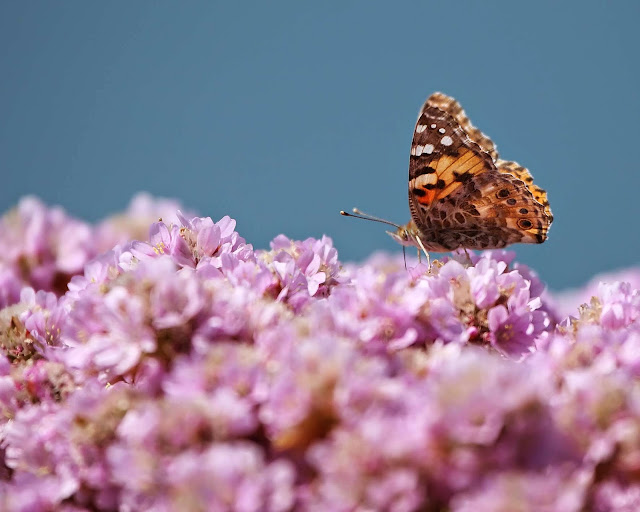On the 25th of last month I travelled to London with my girlfriend Jane, to register for what is becoming an annual event for me, the London Marathon. Obviously running is my main reason for visiting the capital but there are plenty of wildlife watching opportunities to be had especially in the Spring.
After registering at the Xcel Centre, we had pasta for lunch (what else?) then headed for one of my favourite buildings, the Natural History Museum. This temple of the natural sciences in South Kensington was designed in Romanesque style by the architect Alfred Waterhouse and is adorned with intricate carvings of plants and animals. But as any child will tell you the star attractions are the dinosaurs, and a new superstar had recently been unveiled and I was dying to make her acquaintance. Her name is Sophie and she is the most complete Stegosaurus skeleton ever unearthed. With huge plates along her spine and her spiked tail raised in a menacing fashion, Sophie dominated the Earth Hall. I fell for her hook, line and sinker and my girlfriend had to drag me away to enjoy the myriad of other fascinating exhibits on show, or maybe she was jealous of the attention I was giving Sophie! To be fair, palaeontologists are not sure of the sex of this 150 million year old cutie, she was named after the daughter of an unknown benefactor who made the acquisition possible.
 |
| The gorgeous Sophie. |
We enjoyed a long sojourn around the whale hall, but it was soon time for dinner in the shape of more pasta. The day before a marathon is supposed to be one of rest, but London is naturally full of attractions and distractions, and I'm not one to do as I should anyway.
After a good night's sleep I was soon on the train on my way to the marathon start at Blackheath. Many people are inspired to run a marathon by watching the coverage of the race on the BBC. But it is impossible to fully convey in words the emotions involved in this amazing sporting spectacle. The runners, the supporters, the charities, the camaraderie, the fleeting friendships, the noise, the music, the colour, the fancy dress outfits, the struggle, the will power, the support, the shared endeavour; to paraphrase something I heard, if the feelings surrounding the London Marathon could be bottled and shared around the world, life would be immeasurably better for everyone.
I was on the blue start for a change and was able to spot a few celebrities including Jensen Button and Iwan Thomas. But the best sight was the runner dressed as a T-Rex! It was an enormous outfit with working articulated legs attached to the back of his own feet. He deserved a medal just for turning up. Apparently he had even trained near his home dressed in the outfit. Without a doubt it was the best fancy dress I have ever witnessed at a marathon and I was disappointed that there was not more coverage of him on the television.
I had quite a good race and finished in 3 hours and 12 minutes, which means I get automatic entry for next year; maybe I could run as a stegosaurus!
At the start of the race I had ticked off Ring-necked Parakeet for the year flying over the common, and there were plenty more of them to be seen in St. James's Park after the race, along with a motley collection of ducks including Red-crested Pochard. Although a tame Grey Heron was very approachable.
We were up early the next day to visit the Wildfowl and Wetland Centre at Barnes. This is becoming an annual pilgrimage as well; Spring is the perfect time to add a few migrants to my birding year list. We set ourselves the challenge to record as many species of bird as possible in the two hours that we had available to us. But we were distracted by the non-avian delights of this urban wetland. Foremost amongst these was a colony of Marsh Frogs that were calling rapaciously. These are non-native amphibians but are widespread across Europe and are distinguished from the similar Pool and Edible Frogs by their grey vocal sacs.
Other more ephemeral diversions were provided by sulphur-yellow Brimstone butterflies of which we saw at least five different individuals.
But |I mustn't forget the birds. Naturally wetland birds dominated the list including Great-crested and Little Grebes, Common Terns and a couple of Little Ringed Plovers. Another photogenic Grey Heron posed outside one of the hides. Warblers that serenaded us along the lush trails included Willow, Sedge, Reed, Backcap, Chiffchaff and a quite showy Garden Warbler (if you can describe the drabbest-plumaged breeding warbler in Britain as showy!). Which is more then can be said for the Cetti's Warblers exploding into song at every opportunity but as usual remaining completely invisible; I'm sure they employ Klingon cloaking technology!
We recorded a very creditable 50 species of birds in our all-too short time at this urban oasis, but we look forward to visiting again next year to try and beat our target. We celebrated our weekend with a free pint of London Pride given to all marathon finishers by Fuller's in the Euston Flyer pub, before we caught our train back to Chester.
 |
| Marsh Marigold |
 |
| Harry, Paula and me (in blue!) |


















































